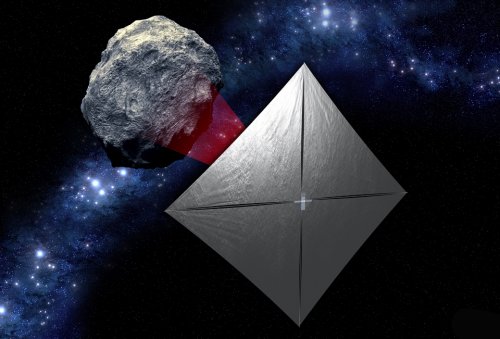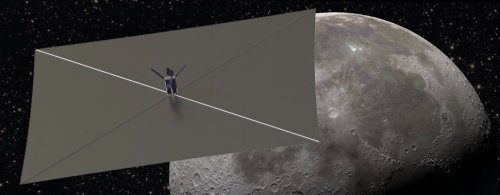The Planetary Society’s LightSail-A, launched on May 20 of this year, demonstrated sail deployment from a CubeSat despite software problems that plagued the mission. You’ll recall that communications were spotty and the upload of a software fix was compromised because of the spacecraft’s continued tumbling. After a series of glitches, the craft’s sail was deployed on the 7th of June, with LightSail-A entering the atmosphere shortly thereafter, a test flight that did achieve its primary objective, serving as a prototype for the upcoming LightSail-1.
Mixing CubeSats with solar sails seems like an excellent idea once we’ve ironed out the wrinkles in the technology, and as I’ve speculated before, we may one day see interplanetary missions carried out by small fleets of CubeSats propelled by solar sails. Although the LightSail-A demonstrator mission was in a low orbit, LightSail-1 will deploy its four triangular sails once it reaches an orbital altitude of 800 kilometers. A key reading will be what sort of increase in the spacecraft’s orbital speed is observed once it deploys its sail at altitude.
We’ll be watching this one with interest in April of next year, when it is scheduled to launch aboard a SpaceX Falcon Heavy, itself the object of great interest (this will be its first launch). Whether the launch goes on time will depend upon how well SpaceX recovers from the recent Falcon 9 launch failure. Whenever it launches, a successful LightSail-1 flight would lead to two more solar sail projects on The Planetary Society’s agenda, with LightSail-3 traveling to the L1 Lagrangian point, a useful position for monitoring geomagnetic activity on the Sun.
NASA, meanwhile, has CubeSat plans of its own, likewise dependent upon the health of a booster, in this case the Space Launch System (SLS) rocket. The first flight of the SLS, planned for 2018, will carry an uncrewed Orion spacecraft to a deep space orbit beyond the Moon and return it to Earth. It’s interesting to see that the first SLS mission, according to this NASA information sheet, has the ability to accommodate eleven 6U-sized CubeSats. The standard 10×10×11 cm basic CubeSat is a ‘one unit’ (1U) CubeSat, but larger platforms of 6U and 12U allow more complex missions (LightSail-1 is built around a 3U CubeSat format).

The future of CubeSats with NASA is confirmed by the Advanced Exploration Systems Division’s choice of three secondary payloads intended for SLS launch and a destination in deep space. BioSentinel is intriguing because it will mark the first time we’ve sent living organisms to deep space since the days of the Apollo missions. The organisms in question are yeast (S. cerevisiae), useful in studying DNA lesions caused by highly energetic particles. The idea is to operate in a deep space radiation environment for eighteen months, measuring the effects of radiation on living organisms at distances far beyond low Earth orbit. So far, the longest human mission in deep space was 12.5 days, accomplished by the crew of Apollo 17.
Image: Conceptual graphic of a radiation particle causing a DNA Double Strand Break (DSB). Credit: NASA.
Crews aboard the International Space Station have obviously spent far longer in space, but only in low-Earth orbit, leaving us with plenty to learn about the effects of deep space on biological systems. Another use of CubeSats will be to scout out important targets near our planet, which is the mission designed for NEA (Near-Earth Asteroid) Scout. Here we have another solar sail/CubeSat combination, allowing maneuvering during cruise for the approach to an asteroid. The plan is to study a small asteroid less than about 90 meters in diameter, homing in on a range of parameters including the asteroid’s shape, rotational properties, spectral class, local dust and debris field, regional morphology and properties of its regolith. Ideally these data will be used to resolve issues related to the eventual human exploration of NEAs.

Image: Near-Earth Asteroid Scout, or NEA Scout, will perform reconnaissance of an asteroid using a CubeSat and solar sail propulsion. Credit: NASA/JPL.
Lunar Flashlight is the third approved mission, a solar sail craft with a 6U CubeSat intended for insertion into lunar orbit to look for ice deposits and areas best suited for resource extraction by future human crews. So this one is likewise a scout, one whose sail will be able to reflect 50 kW of sunlight and light up dark craters at the lunar poles where surface water ice may be lurking. It’s also the first mission that will attempt to fly an 80 m2 solar sail. Repeated measurements will give us a chart of ice concentrations in these regions, while also building a catalog of places rich enough in materials to support in-situ resource utilization (ISRU).

Image: Lunar Flashlight will map the lunar south pole for volatiles and demonstrate several technological firsts, including being the first CubeSat to reach the Moon, the first mission to use an 80 m2 solar sail, and the first mission to use a solar sail as a reflector for science observations. Credit: NASA/MSFC.
The CubeSats designed for the first SLS mission won’t get a lot of the publicity when the big rocket flies, but if they perform as expected, they’ll be pushing the small modular satellite concept into new areas. Particularly with regard to solar sails, NEA Scout and Lunar Flashlight should give us opportunities to navigate and maneuver with sails, building experience for the larger sail missions of the future. Meanwhile, Japan’s IKAROS sail, in its ten-month solar orbit, remains in hibernation, with its fifth wake-up call scheduled for winter of this year. Remember that a 50 meter sail, an ambitious successor to IKAROS designed for a mission to Jupiter and the Trojan asteroids, is in the works, with launch some time later in the decade.



Wonderful to see that sails are now being used for a few missions. The small mass cubesats no doubt help in this regard, as the sails can be small and more easily deployed. These missions should help us gain experience with this propulsion technology and how to improve it. I hope this impacts sail design, much as we saw during the age of sailing ships.
For the asteroid mission, how will the sails allow maneuvering? With other propulsion systems, they can be turned on and off, but sails are always on. Are they, or the cubesat, dynamically orientated to change thrust, or furled in some way (this latter seems unlikely)?
Although the sample size for the Apollo 17 mission is only three people, none died of cancer. Two (Cernan, Schmidt) are alive and well and in their 80s, and one (Evans) died of a heart attack at age 56.
It’s all about survivable avionics and instruments outside of the van allen belts and communications.JPL tells me UHF works to within 500,000 kilometers which is good enough for a Phobos/Deimos cubesat to talk to a spacecraft that has ELETRA onboard
http://www.marscat.space/science/implementation
Asterids need larger earth based receivers and there is a limit to how many AU a cubesat(less than 1 AU) can be without a mother ship
If you tack a solar sail so its line of site does not result in illumination will work how you do this when in orbit about a very small body is answered perhaps by never entering orbit but flying alongside
Phobos-Grunt was going to carry some life forms all the way to Mars and back to see how their fared as part of a panspermia experiment, but the unfortunate creatures never left Earth orbit:
http://www.planetary.org/explore/projects/life/
Since we know they could not fully sterilize a lander, and it is especially possible that the Soviets did even less in that department, it would be worthwhile to find and examine landers on other worlds to see if any microbes survived and what they had been doing since.
And no, they did NOT find a living microbe on Surveyor 3 taken back by the Apollo 12 mission in 1969:
http://www.space.com/11536-moon-microbe-mystery-solved-apollo-12.html
Could a cubesat with a MAGSAIL use Saturn’s magnetic field to slow down enough to enter into orbit around Enceladus? The reason I am asking this right now, is, in case you haven’t heard yet, IT”S OFFICIAL: Enceladus has a sub-surface GLOBAL OCEAN, instead of just a sub-surface LAKE. This, in my opinion, increases the chances for life there TENFOLD, AT LEAST!
I want to send a couple of these to Venus, since they’ll have even more solar power to work with if you stuck a few in orbit to look at its atmosphere.
That Lunar Flashlight sounds intriguing. Could you find something incredibly valuable near the lunar surface that way? I’ve often wondered what the reaction would be if we found a massive lunar near-surface deposit of valuable rare metals (think gold and the platinum group) on part of the Moon.
“The sky’s awash with glitter.”
How I’ve longed to see solar sailing missions coming to the fore and reading an article outlining so many current plans it feels as if the tide has turned and we’re finally going somewhere with this tech.
Alex is right to point out the advances and advantages with Cubesats. It seemed to me that the goal of solar-sailing might never happen given the tight budgets involved… but then along came the Cubesats to save the day. Who knew? Without the small cost and relative ease for getting these things up there we would still be waiting. I fervently hope we can iron-out the kinks early on so this technology becomes almost first-choice for future missions… kinda makes the reality of a large helio-gyro type mission seem a lot firmer and a lot sooner.
Does anyone know just how maneuverable Ikaros is/was with it’s LCD system for attitude control; basically does it work and if so how well?
When the technology is more mature, one idea I would like seen done is to use some technique to make the sail into a parabolic reflector so that the cubesat can send its transmissions further/faster. Perhaps memory alloy wires in the sail material might do the trick, or inflatable spars. The sail would be flat for the journey, then become parabolic at the destination (or for transmissions and reception at various times during the flight).
Like Mark, I am also interested in how well the IKAROS system worked for maneuvering. The solid state approach was novel and very different from prior schemes. How well did it work and what was the performance of the LCDs over time?
I found this on JAXAs site from the July 2010 ‘attitude control test’…
http://global.jaxa.jp/press/2010/07/20100723_ikaros_e.html
While it’s an old document it does give mention of how much control they got.
China just launched a fleet of 20 micro-satellites on their new Long March 6 rocket:
http://www.spaceflightinsider.com/missions/earth-science/chinese-long-march-6-rocket-orbits-swarm-of-small-satellites-on-maiden-flight/